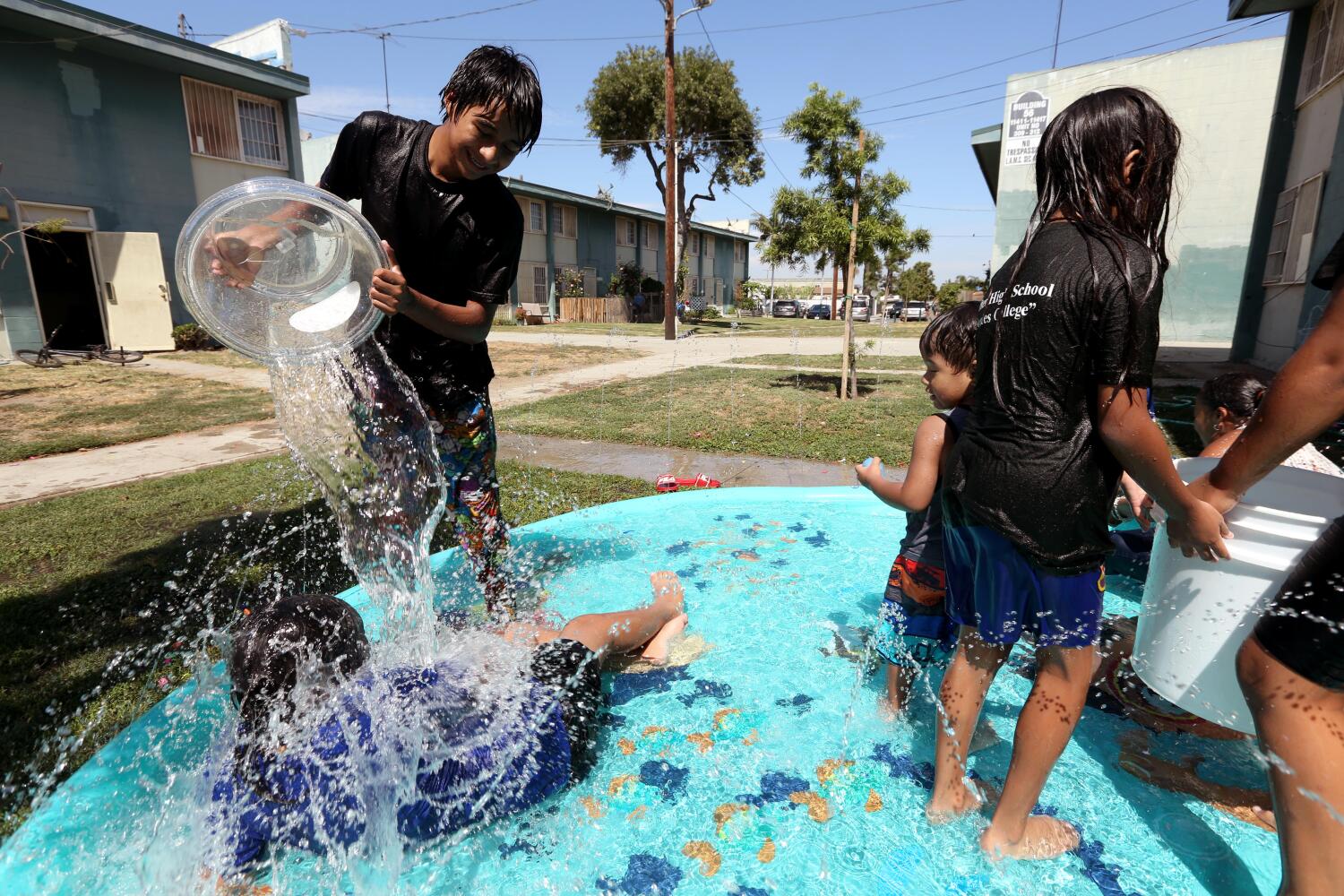-
Mets Likely To Sign Pete Alonso Amid Depleted First Base Market - 7 mins ago
-
Trump Picks Callista Gingrich for Ambassador to Switzerland - 10 mins ago
-
NASCAR Cup Series Team Confirms 2025 Daytona 500 Entry Plans - 42 mins ago
-
Trump Names His Picks for Top Pentagon Roles - 54 mins ago
-
The IRS might be dropping $1,400 into your stocking this year - about 1 hour ago
-
Phillies Likely To Hold Onto Alec Bohm Following Jesús Luzardo Trade - about 1 hour ago
-
How Airlines Pick the Movies on Your Flights - 2 hours ago
-
Two injured in crash of small plane on Carson golf course - 2 hours ago
-
Mets Could Lose $152 Million Pete Alonso To Dark Horse Rangers - 2 hours ago
-
Campus Groups Try to Make Room for Middle-Ground Opinions on the Middle East - 2 hours ago
Los Angeles investigating lead-tainted drinking water

Days after the administrator of the U.S. Environmental Protection Agency visited a Los Angeles public housing project with lead-contaminated water, the agency ordered drinking water systems nationwide to replace every lead pipe within 10 years.
“We’ve known for decades that lead exposure has serious long-term impacts for children’s health. And yet, millions of lead service lines are still delivering drinking water to homes,” EPA Director Michael Regan said.
But in Los Angeles — where the discovery of contaminated water in public housing in Watts has shocked officials — the EPA mandate is unlikely to result in immediate change.
When Regan joined Mayor Karen Bass on a visit to the 700-unit Jordan Downs complex this month, he suggested the brain-damaging element could be from household plumbing — a critical risk in older homes.
It’s a possibility that highlights the difficulty of eliminating the threat of lead in California drinking water.
While the new EPA rule targets lead service lines connecting homes to water mains, it doesn’t address plumbing inside the building that can still pose a risk, such as lead soldering, brass fixtures and interior mains.
“If you can outlaw lead in fuel, for God’s sake, why can’t we outlaw lead in drinking water?” asked Timothy Watkins, president of the Watts Labor Community Action Committee. “And in all plumbing components, faucets, valves, pipes — you name it.”
Although the installation of lead service lines was banned in 1986, around 9 million homes nationwide still receive tap water through these aging pipelines, according to EPA estimates. Over time, as these pipes have corroded, they have leached lead — a chemical with no safe level of exposure — into tap water. When ingested by children, the heavy metal can cause irreversible brain damage and behavioral issues.
The Natural Resources Defense Council has long advocated for addressing widespread problems of lead-contaminated drinking water. The environmental group has called for more testing and replacement of lead pipes. It has also criticized California officials for not taking advantage of federal funds available under the Bipartisan Infrastructure Law to pay for the removal of lead from drinking water systems.
“We have a very limited understanding of the number of lead pipes in California, in part because the state has done such a poor job of collecting data for so long,” said Steve Fleischli, the Natural Resources Defense Council’s senior director for air and water.
Operators of water systems throughout California were required to submit information this month to state water regulators on the presence of lead pipes.
The Los Angeles Department of Water and Power insists there are no lead pipelines requiring replacement within its nearly 745,000 connections.
For its federally mandated report, DWP reviewed historical records and inspected nearly 42,000 service lines citywide, discovering no lead pipelines or galvanized lines that can harbor contaminants. Based on its review, the water department says “the remaining service lines can be assumed to be non-lead with a certain level of confidence.”
The Housing Authority of the City of Los Angeles says the water lines to four Watts housing complexes — Jordan Downs, Nickerson Gardens, Imperial Courts and Gonzaque Village — are made of galvanized steel or copper.
Worries over lead contamination arose recently, after a team of researchers collected water samples from properties owned by the Housing Authority of the City of Los Angeles: Five units in Nickerson Gardens, two in Jordan Downs and one in Imperial Courts contained detectable levels of lead.
The findings alarmed Bass, who called on the DWP and housing authority to investigate the extent of lead contamination in thousands of city-owned subsidized housing units, and identify the source.
Preliminary results suggest the issue is widespread.
So far, more than 340 water samples from kitchen faucets in Nickerson Gardens and Jordan Downs have been tested. Lead was detected in more than 100 Nickerson Gardens samples, and more than 40 in Jordan Downs, according to data provided by the housing authority.
Housing officials say only five samples measured over 5 parts per billion for lead. They say they have not yet identified a clear trend or source of the lead yet.
Watkins, however, argued that there is no safe concentration of lead in drinking water.
“They can detect it down to one part per billion, which is still a threat,” Watkins said. “They didn’t seem to understand that it’s the cumulative effect of lead exposure that is the threat. It’s not the single, it’s not a single dose.”
An additional 700 water samples have been collected from water hose spigots at Nickerson Gardens and Imperial Courts. Nearly 600 of these samples contained lead — and at much higher levels. The housing authority has used handheld devices to analyze the lead composition of the hose connections and replaced fixtures where high levels were found.
The initial sampling effort started with hose spigots, which could be collected quickly and provide insight on interior plumbing. But the housing authority says it found no correlation between the concentrations of lead found at the spigots and kitchen faucets, prompting them to prioritize in-unit testing.
“The limited higher lead detections have been predominantly in our hose bibs, which serve as an external water source for outdoor watering or general water releases,” the housing authority said in a statement.
“HACLA has been primarily concerned about getting a better understanding of any potential lead concentrations in the water our residents are using regularly, therefore we pivoted to engage in the wider in-unit testing as soon as preliminary test results did appear to indicate a correlation between the hose bibs and in-unit testing results.”
Asked if hose water could pose a risk to the public, the housing authority deferred questions to the EPA and public health officials. It said it has removed hose fixtures where elevated levels of lead were detected.
Although water from the exterior hose is not considered potable water, it can act as a conduit for contaminated water, according to Danielle Hoague, a doctoral student at UCLA and lead author of the community-led water sampling study. This summer, as she and other researchers went door-to-door, she worried about the children she saw attempting to beat the heat.
“I saw multiple kiddie pools that people filled up for their kids to play in,” Hoague said. “I doubt that was from water bottles. That was likely from the hoses. HACLA has been very unclear about how they are watering the grass, but if they were using both the hose bibs and hoses, it’s likely that that water could turn into dust on the grass that could be transferred. So it is of concern. Eventually, we would like to move on to soil testing at these sites.”
For Watkins, the community activist, he often thinks about the human toll of lead exposure in his community.
In the recent EPA announcement, the agency said the replacement of lead pipelines will prevent as many as 200,000 lost IQ points in children. That’s why it angers Watkins to hear some dismiss concerns about so-called lower levels of lead.
“That’s nothing — until a child gets to the third grade and stops progressing,” Watkins said. “And the parents are scratching their heads trying to figure out what happened, and when that child becomes impetuous and oblivious to discipline and becomes destructive and violent and the school doesn’t want the kid in a regular class.”
Newsletter
Toward a more sustainable California
Get Boiling Point, our newsletter exploring climate change, energy and the environment, and become part of the conversation — and the solution.
You may occasionally receive promotional content from the Los Angeles Times.
Source link

















